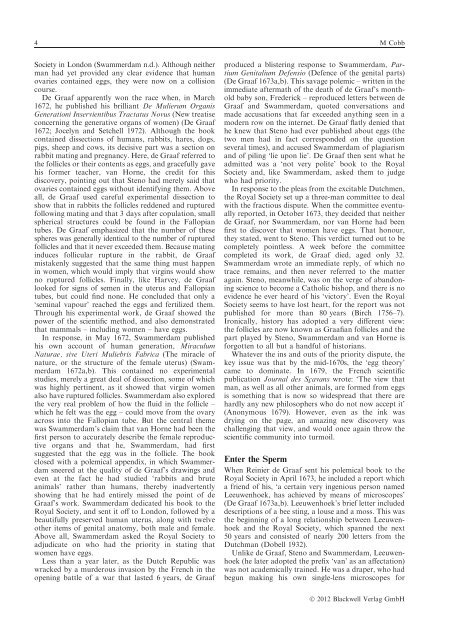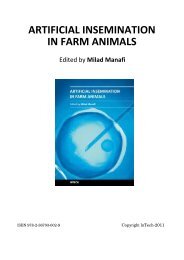The Discovery of Egg and Sperm in the 17th Century - Phenix-Vet
The Discovery of Egg and Sperm in the 17th Century - Phenix-Vet
The Discovery of Egg and Sperm in the 17th Century - Phenix-Vet
You also want an ePaper? Increase the reach of your titles
YUMPU automatically turns print PDFs into web optimized ePapers that Google loves.
4 M CobbSociety <strong>in</strong> London (Swammerdam n.d.). Although nei<strong>the</strong>rman had yet provided any clear evidence that humanovaries conta<strong>in</strong>ed eggs, <strong>the</strong>y were now on a collisioncourse.De Graaf apparently won <strong>the</strong> race when, <strong>in</strong> March1672, he published his brilliant De Mulierum OrganisGenerationi Inservientibus Tractatus Novus (New treatiseconcern<strong>in</strong>g <strong>the</strong> generative organs <strong>of</strong> women) (De Graaf1672; Jocelyn <strong>and</strong> Setchell 1972). Although <strong>the</strong> bookconta<strong>in</strong>ed dissections <strong>of</strong> humans, rabbits, hares, dogs,pigs, sheep <strong>and</strong> cows, its decisive part was a section onrabbit mat<strong>in</strong>g <strong>and</strong> pregnancy. Here, de Graaf referred to<strong>the</strong> follicles or <strong>the</strong>ir contents as eggs, <strong>and</strong> gracefully gavehis former teacher, van Horne, <strong>the</strong> credit for thisdiscovery, po<strong>in</strong>t<strong>in</strong>g out that Steno had merely said thatovaries conta<strong>in</strong>ed eggs without identify<strong>in</strong>g <strong>the</strong>m. Aboveall, de Graaf used careful experimental dissection toshow that <strong>in</strong> rabbits <strong>the</strong> follicles reddened <strong>and</strong> rupturedfollow<strong>in</strong>g mat<strong>in</strong>g <strong>and</strong> that 3 days after copulation, smallspherical structures could be found <strong>in</strong> <strong>the</strong> Fallopiantubes. De Graaf emphasized that <strong>the</strong> number <strong>of</strong> <strong>the</strong>sespheres was generally identical to <strong>the</strong> number <strong>of</strong> rupturedfollicles <strong>and</strong> that it never exceeded <strong>the</strong>m. Because mat<strong>in</strong>g<strong>in</strong>duces follicular rupture <strong>in</strong> <strong>the</strong> rabbit, de Graafmistakenly suggested that <strong>the</strong> same th<strong>in</strong>g must happen<strong>in</strong> women, which would imply that virg<strong>in</strong>s would showno ruptured follicles. F<strong>in</strong>ally, like Harvey, de Graaflooked for signs <strong>of</strong> semen <strong>in</strong> <strong>the</strong> uterus <strong>and</strong> Fallopiantubes, but could f<strong>in</strong>d none. He concluded that only a‘sem<strong>in</strong>al vapour’ reached <strong>the</strong> eggs <strong>and</strong> fertilized <strong>the</strong>m.Through his experimental work, de Graaf showed <strong>the</strong>power <strong>of</strong> <strong>the</strong> scientific method, <strong>and</strong> also demonstratedthat mammals – <strong>in</strong>clud<strong>in</strong>g women – have eggs.In response, <strong>in</strong> May 1672, Swammerdam publishedhis own account <strong>of</strong> human generation, MiraculumNaturae, sive Uteri Muliebris Fabrica (<strong>The</strong> miracle <strong>of</strong>nature, or <strong>the</strong> structure <strong>of</strong> <strong>the</strong> female uterus) (Swammerdam1672a,b). This conta<strong>in</strong>ed no experimentalstudies, merely a great deal <strong>of</strong> dissection, some <strong>of</strong> whichwas highly pert<strong>in</strong>ent, as it showed that virg<strong>in</strong> womenalso have ruptured follicles. Swammerdam also explored<strong>the</strong> very real problem <strong>of</strong> how <strong>the</strong> fluid <strong>in</strong> <strong>the</strong> follicle –which he felt was <strong>the</strong> egg – could move from <strong>the</strong> ovaryacross <strong>in</strong>to <strong>the</strong> Fallopian tube. But <strong>the</strong> central <strong>the</strong>mewas Swammerdam’s claim that van Horne had been <strong>the</strong>first person to accurately describe <strong>the</strong> female reproductiveorgans <strong>and</strong> that he, Swammerdam, had firstsuggested that <strong>the</strong> egg was <strong>in</strong> <strong>the</strong> follicle. <strong>The</strong> bookclosed with a polemical appendix, <strong>in</strong> which Swammerdamsneered at <strong>the</strong> quality <strong>of</strong> de Graaf’s draw<strong>in</strong>gs <strong>and</strong>even at <strong>the</strong> fact he had studied ‘rabbits <strong>and</strong> bruteanimals’ ra<strong>the</strong>r than humans, <strong>the</strong>reby <strong>in</strong>advertentlyshow<strong>in</strong>g that he had entirely missed <strong>the</strong> po<strong>in</strong>t <strong>of</strong> deGraaf’s work. Swammerdam dedicated his book to <strong>the</strong>Royal Society, <strong>and</strong> sent it <strong>of</strong>f to London, followed by abeautifully preserved human uterus, along with twelveo<strong>the</strong>r items <strong>of</strong> genital anatomy, both male <strong>and</strong> female.Above all, Swammerdam asked <strong>the</strong> Royal Society toadjudicate on who had <strong>the</strong> priority <strong>in</strong> stat<strong>in</strong>g thatwomen have eggs.Less than a year later, as <strong>the</strong> Dutch Republic waswracked by a murderous <strong>in</strong>vasion by <strong>the</strong> French <strong>in</strong> <strong>the</strong>open<strong>in</strong>g battle <strong>of</strong> a war that lasted 6 years, de Graafproduced a blister<strong>in</strong>g response to Swammerdam, PartiumGenitalium Defensio (Defence <strong>of</strong> <strong>the</strong> genital parts)(De Graaf 1673a,b). This savage polemic – written <strong>in</strong> <strong>the</strong>immediate aftermath <strong>of</strong> <strong>the</strong> death <strong>of</strong> de Graaf’s montholdbaby son, Frederick – reproduced letters between deGraaf <strong>and</strong> Swammerdam, quoted conversations <strong>and</strong>made accusations that far exceeded anyth<strong>in</strong>g seen <strong>in</strong> amodern row on <strong>the</strong> <strong>in</strong>ternet. De Graaf flatly denied tha<strong>the</strong> knew that Steno had ever published about eggs (<strong>the</strong>two men had <strong>in</strong> fact corresponded on <strong>the</strong> questionseveral times), <strong>and</strong> accused Swammerdam <strong>of</strong> plagiarism<strong>and</strong> <strong>of</strong> pil<strong>in</strong>g ‘lie upon lie’. De Graaf <strong>the</strong>n sent what headmitted was a ‘not very polite’ book to <strong>the</strong> RoyalSociety <strong>and</strong>, like Swammerdam, asked <strong>the</strong>m to judgewho had priority.In response to <strong>the</strong> pleas from <strong>the</strong> excitable Dutchmen,<strong>the</strong> Royal Society set up a three-man committee to dealwith <strong>the</strong> fractious dispute. When <strong>the</strong> committee eventuallyreported, <strong>in</strong> October 1673, <strong>the</strong>y decided that nei<strong>the</strong>rde Graaf, nor Swammerdam, nor van Horne had beenfirst to discover that women have eggs. That honour,<strong>the</strong>y stated, went to Steno. This verdict turned out to becompletely po<strong>in</strong>tless. A week before <strong>the</strong> committeecompleted its work, de Graaf died, aged only 32.Swammerdam wrote an immediate reply, <strong>of</strong> which notrace rema<strong>in</strong>s, <strong>and</strong> <strong>the</strong>n never referred to <strong>the</strong> matteraga<strong>in</strong>. Steno, meanwhile, was on <strong>the</strong> verge <strong>of</strong> ab<strong>and</strong>on<strong>in</strong>gscience to become a Catholic bishop, <strong>and</strong> <strong>the</strong>re is noevidence he ever heard <strong>of</strong> his ‘victory’. Even <strong>the</strong> RoyalSociety seems to have lost heart, for <strong>the</strong> report was notpublished for more than 80 years (Birch 1756–7).Ironically, history has adopted a very different view:<strong>the</strong> follicles are now known as Graafian follicles <strong>and</strong> <strong>the</strong>part played by Steno, Swammerdam <strong>and</strong> van Horne isforgotten to all but a h<strong>and</strong>ful <strong>of</strong> historians.Whatever <strong>the</strong> <strong>in</strong>s <strong>and</strong> outs <strong>of</strong> <strong>the</strong> priority dispute, <strong>the</strong>key issue was that by <strong>the</strong> mid-1670s, <strong>the</strong> ‘egg <strong>the</strong>ory’came to dom<strong>in</strong>ate. In 1679, <strong>the</strong> French scientificpublication Journal des Sçavans wrote: ‘<strong>The</strong> view thatman, as well as all o<strong>the</strong>r animals, are formed from eggsis someth<strong>in</strong>g that is now so widespread that <strong>the</strong>re arehardly any new philosophers who do not now accept it’(Anonymous 1679). However, even as <strong>the</strong> <strong>in</strong>k wasdry<strong>in</strong>g on <strong>the</strong> page, an amaz<strong>in</strong>g new discovery waschalleng<strong>in</strong>g that view, <strong>and</strong> would once aga<strong>in</strong> throw <strong>the</strong>scientific community <strong>in</strong>to turmoil.Enter <strong>the</strong> <strong>Sperm</strong>When Re<strong>in</strong>ier de Graaf sent his polemical book to <strong>the</strong>Royal Society <strong>in</strong> April 1673, he <strong>in</strong>cluded a report whicha friend <strong>of</strong> his, ‘a certa<strong>in</strong> very <strong>in</strong>genious person namedLeeuwenhoek, has achieved by means <strong>of</strong> microscopes’(De Graaf 1673a,b). Leeuwenhoek’s brief letter <strong>in</strong>cludeddescriptions <strong>of</strong> a bee st<strong>in</strong>g, a louse <strong>and</strong> a moss. This was<strong>the</strong> beg<strong>in</strong>n<strong>in</strong>g <strong>of</strong> a long relationship between Leeuwenhoek<strong>and</strong> <strong>the</strong> Royal Society, which spanned <strong>the</strong> next50 years <strong>and</strong> consisted <strong>of</strong> nearly 200 letters from <strong>the</strong>Dutchman (Dobell 1932).Unlike de Graaf, Steno <strong>and</strong> Swammerdam, Leeuwenhoek(he later adopted <strong>the</strong> prefix ‘van’ as an affectation)was not academically tra<strong>in</strong>ed. He was a draper, who hadbegun mak<strong>in</strong>g his own s<strong>in</strong>gle-lens microscopes forÓ 2012 Blackwell Verlag GmbH










